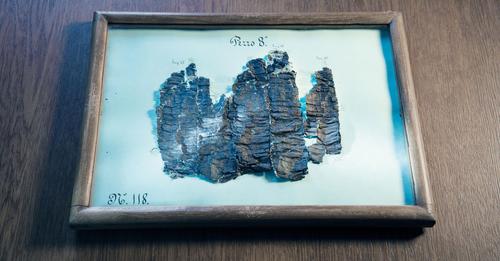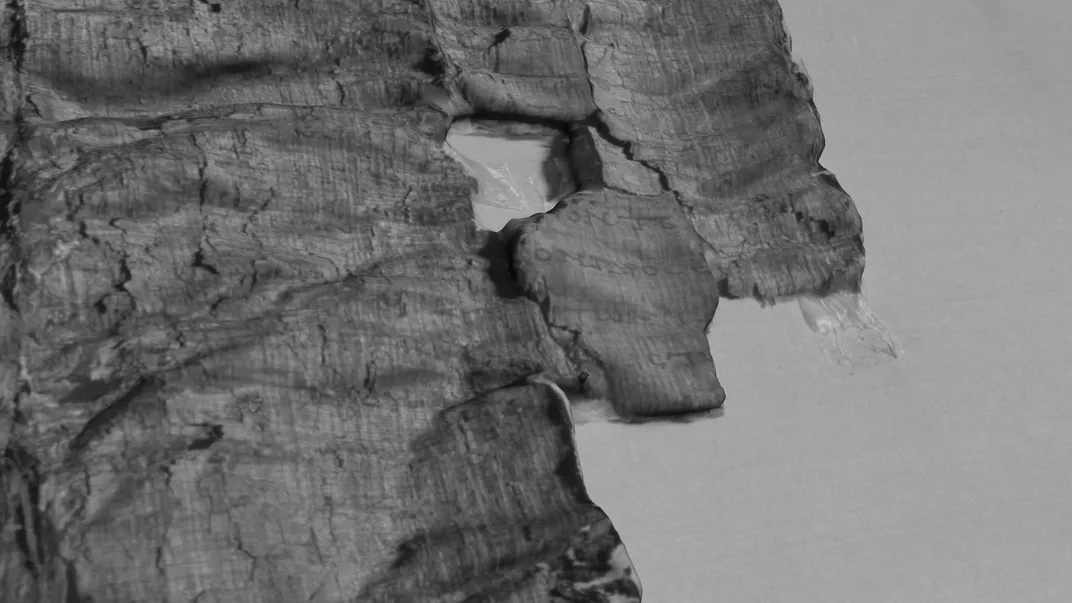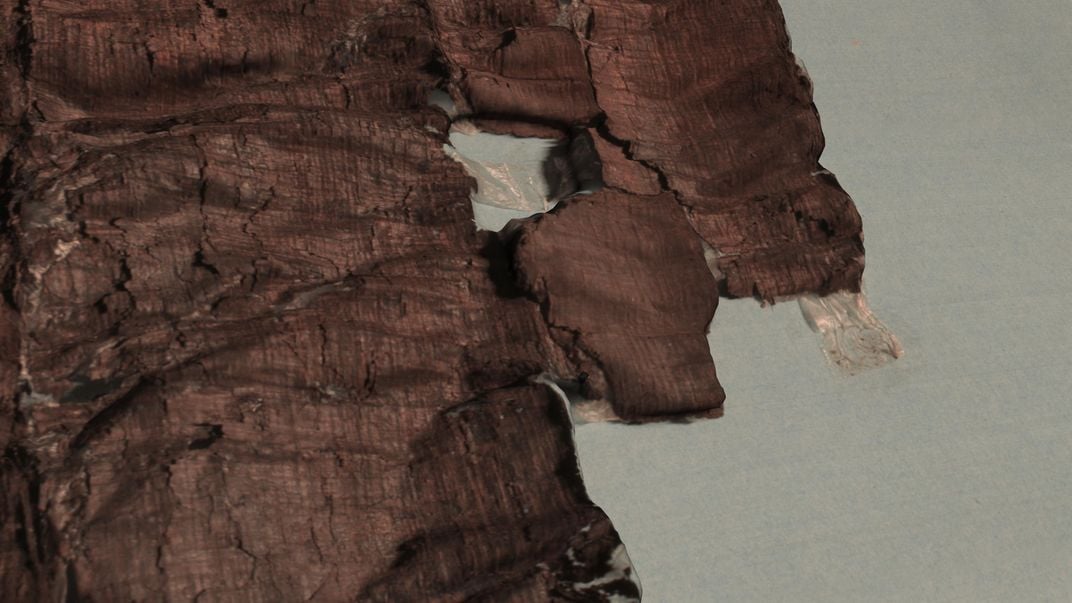/https://tf-cmsv2-smithsonianmag-media.s3.amazonaws.com/filer/b4/00/b400566a-ff05-4ad5-b440-f1301176b31c/julaug2018_c04_scrolls.jpg)
Henrik Knudsen
It’s July 12, 2017, and Jens Dopke walks into a windowless room in Oxfordshire, England, all of his attention trained on a small, white frame that he carries with both hands. The space, which looks like a futuristic engine room, is crowded with sleek metal tables, switches and platforms topped with tubes and boxes. A tangle of pipes and wires covers the walls and floor like vines.
In the middle of the room, Dopke, a physicist, eases the frame into a holder mounted on a metal turntable, a red laser playing on the back of his hand. Then he uses his cellphone to call his colleague Michael Drakopoulos, who is sitting in a control room a few yards away. “Give it another half a millimeter,” Dopke says. Working together, they adjust the turntable so that the laser aligns perfectly with a dark, charred speck at the center of the frame.
Dozens of similar rooms, or “hutches,” are arrayed around this huge, doughnut-shaped building, a type of particle accelerator called a synchrotron. It propels electrons to near light speed around its 500-meter-long ring, bending them with magnets so they emit light. The resulting radiation is focused into intense beams, in this case high-energy X-rays, which travel through each hutch. That red laser shows the path the beam will take. A thick lead shutter, attached to the wall, is all that stands between Dopke and a blast of photons ten billion times brighter than the Sun.
The facility, called Diamond Light Source, is one of the most powerful and sophisticated X-ray facilities in the world, used to probe everything from viruses to jet engines. On this summer afternoon, though, its epic beam will focus on a tiny crumb of papyrus that has already survived one of the most destructive forces on the planet—and 2,000 years of history. It comes from a scroll found in Herculaneum, an ancient Roman resort on the Bay of Naples, Italy, that was buried by the eruption of Mount Vesuvius in A.D. 79. In the 18th century, workmen employed by King Charles III of Spain, then in charge of much of southern Italy, discovered the remains of a magnificent villa, thought to have belonged to Lucius Calpurnius Piso Caesoninus (known as Piso), a wealthy statesman and the father-in-law of Julius Caesar. The luxurious residence had elaborate gardens surrounded by colonnaded walkways and was filled with beautiful mosaics, frescoes and sculptures. And, in what was to become one of the most frustrating archaeological discoveries ever, the workmen also found approximately 2,000 papyrus scrolls.
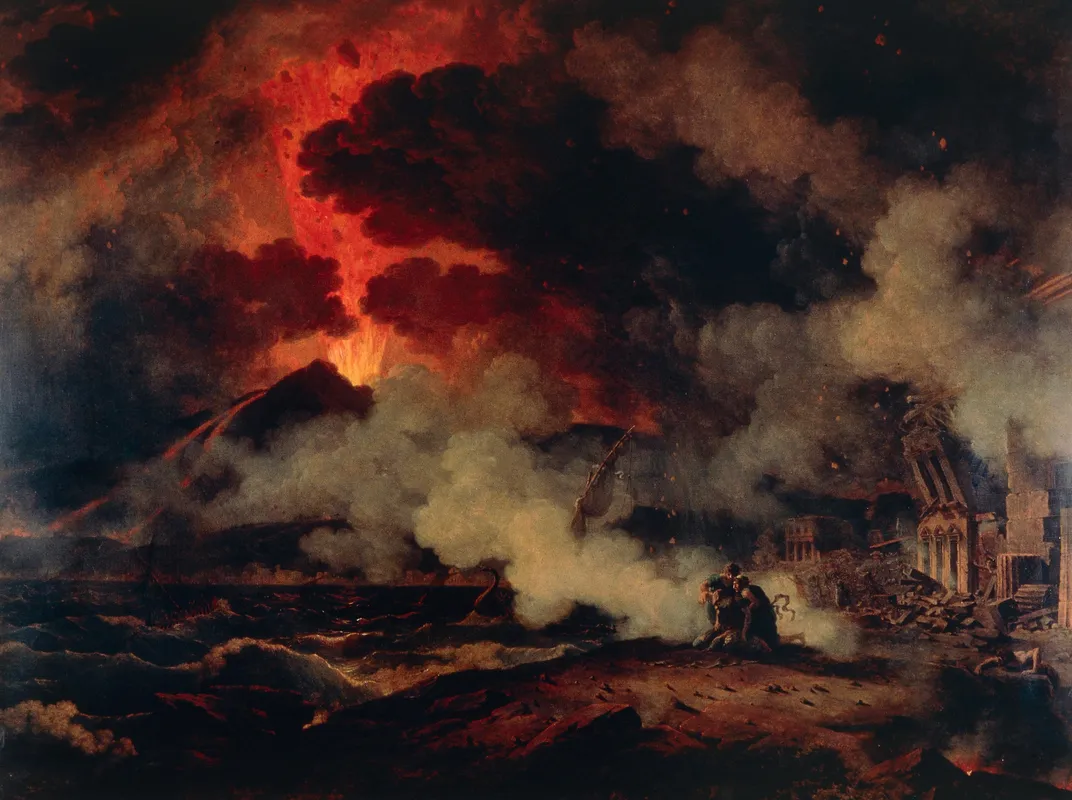
Deagostini / Getty Images
The scrolls represent the only intact library known from the classical world, an unprecedented cache of ancient knowledge. Most classical texts we know today were copied, and were therefore filtered and distorted, by scribes over centuries, but these works came straight from the hands of the Greek and Roman scholars themselves. Yet the tremendous volcanic heat and gases spewed by Vesuvius carbonized the scrolls, turning them black and hard like lumps of coal. Over the years, various attempts to open some of them created a mess of fragile flakes that yielded only brief snippets of text. Hundreds of the papyri were therefore left unopened, with no realistic prospect that their contents would ever be revealed. And it probably would have remained that way except for an American computer scientist named Brent Seales, director of the Center for Visualization & Virtual Environments at the University of Kentucky.
Seales is in the control room now, watching intently: frowning, hands in pockets, legs wide.
The papyrus scrap in the white frame, held between two layers of transparent orange film, is just three millimeters across, and sports one barely visible letter: an old-fashioned Greek character called a lunate sigma, which looks like a lowercase “c.” Next to the turntable, shielded inside a tungsten tube, is a high-resolution X-ray detector, called HEXITEC, that has taken engineers ten years to develop. Seales believes that it will pick up the desperately faint signal he’s looking for and, in doing so, “read” the tiny Greek letter. “When I started thinking about this, this technology didn’t exist,” he says. “I don’t think there’s another detector in the world right now that could do this kind of measurement.” If it works, imaging the single letter on this charred crumb could help to unlock the secrets of the entire library.
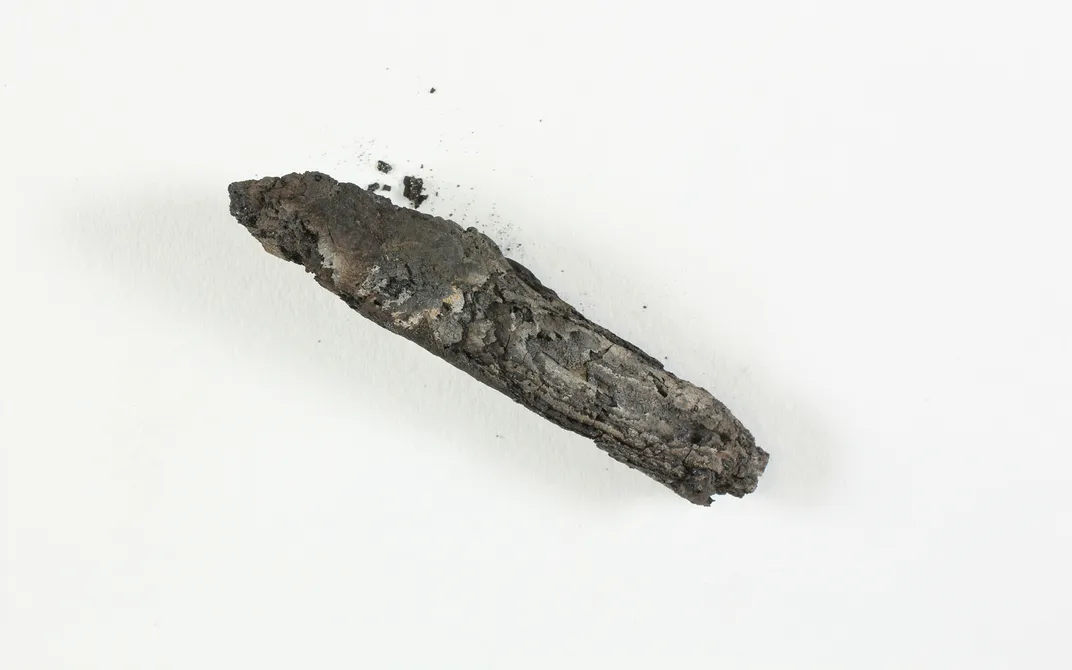
Courtesy of the Leon Levy Dead Sea Scrolls Digital Library, IAA. Photo: S. Halevi
A wailing alarm sounds as Dopke exits the hutch before Drakopoulos swings shut the 1,500-pound, lead-lined door. Back in the control room, computer screens show a live feed of the papyrus from multiple angles as Drakopoulos clicks his mouse to raise the shutter and flood the hutch with radiation. Sitting next to him, an engineer prepares to capture data from the detector. “Ready?” he asks. “I’m going to press Play.”
**********
Seales, who is 54, has wide-set eyes beneath a prominent brow, and an air of sincere and abiding optimism. He’s an unlikely pioneer in papyrus studies. Brought up near Buffalo, New York, he has no training in the classics. While European curators and textual scholars yearn to discover lost works of classical literature in the Herculaneum scrolls, Seales, an evangelical Christian, dreams of finding letters written by the apostle Paul, who was said to have traveled around Naples in the years before Vesuvius erupted.
Seales came of age in the 1970s and ’80s—the era of early video games, when big-dreaming Californians were building computers in their garages—and he was a techie from a young age. With no money for college, but with a brain for complex mathematics and music (he played violin at his local church), Seales won a double scholarship from the University of Southwestern Louisiana to study computer science and music. Later, while earning his doctorate, at the University of Wisconsin, he became fascinated with “computer vision,” and began writing algorithms to convert two-dimensional photographs into 3-D models—a technique that later enabled vehicles such as Mars rovers, for example, to navigate terrain on their own. Seales went to work at the University of Kentucky in 1991, and when a colleague took him along to the British Library to photograph fragile manuscripts, Seales, captivated by the idea of seeing the unseeable, found the challenge thrilling.
The British Library project was part of a “digital renaissance” in which millions of books and hundreds of thousands of manuscripts were photographed for posterity and stored online. Seales helped make a digital version of the only surviving copy of the Old English epic poem Beowulf, using ultraviolet light to enhance the surviving text. But working with the warped, cockled pages made him realize the inadequacy of two-dimensional photographs, in which words can be distorted or hidden in creases and folds.
So in 2000, he created three-dimensional computer models of the pages of a damaged manuscript, Otho B.x (an 11th-century collection of saints’ lives), then developed an algorithm to stretch them, producing an artificial “flat” version that didn’t exist in reality. When that worked, he wondered if he could go even further, and use digital imaging not just to flatten crinkled pages but to “virtually unwrap” unopened scrolls—and reveal texts that hadn’t been read since antiquity. “I realized that no one else was doing this,” he says.
He began to experiment with a medical-grade computed tomography (or CT) scanner, which uses X-rays to create a three-dimensional image of an object’s internal structure. First, he tried imaging the paint on a modern rolled-up canvas. Then he scanned his first authentic object—a 15th-century bookbinding thought to contain a fragment of Ecclesiastes hidden inside. It worked.
Buoyed by his success, Seales imagined reading fragments of the Dead Sea Scrolls, which include the oldest biblical writings ever found, dating to as far back as the third century B.C., sections of which remain unopened today. Then, in 2005, a classicist colleague took him to Naples, where many of the excavated Herculaneum scrolls are displayed at the National Library, a few steps from a window with a view across the bay to Vesuvius itself. Seared by gases at hundreds of degrees centigrade and superheated volcanic materials that in time hardened into 60 feet of rock, the distorted, crumbling rolls were believed by most scholars to be the very definition of a lost cause.
For Seales, viewing them was an “almost otherworldly” experience, he says. “I realized that there were many dozens, probably hundreds, of these intact scrolls, and nobody had the first idea about what the text might be. We were looking at manuscripts that represent the biggest mysteries that I can imagine.”
**********
He isn’t the first to try to solve these mysteries. In 1752, when Charles III’s workmen found the carbonized lumps inside what’s now known as the Villa dei Papiri, they assumed they were pieces of coal and burned them or threw them in the sea. But once they were identified as scrolls, Camillo Paderni, an artist in charge of the recovered antiquities, set about opening the remaining ones. His method involved slicing the rolls in half, copying any visible text, then scraping away each layer in turn to reveal what was beneath. Hundreds of rolls were transcribed that way—and destroyed in the process.
In 1754, a Vatican priest and conservator named Antonio Piaggio dreamed up a new scheme: He glued goldbeater’s skin (a calf’s extremely thin yet tough intestinal membrane) to a scroll’s surface, then used a contraption involving weights on strings to ease it open. Artists watched this excruciatingly slow process and copied any exposed writing in pencil sketches known as disegni. Many of the flaky outer layers of the scrolls were removed before the inner portion could be unwound, and the papyrus often tore off in narrow strips, leaving layers stuck together. Hundreds of scrolls were pulled apart using Piaggio’s machine, but they revealed only limited text.
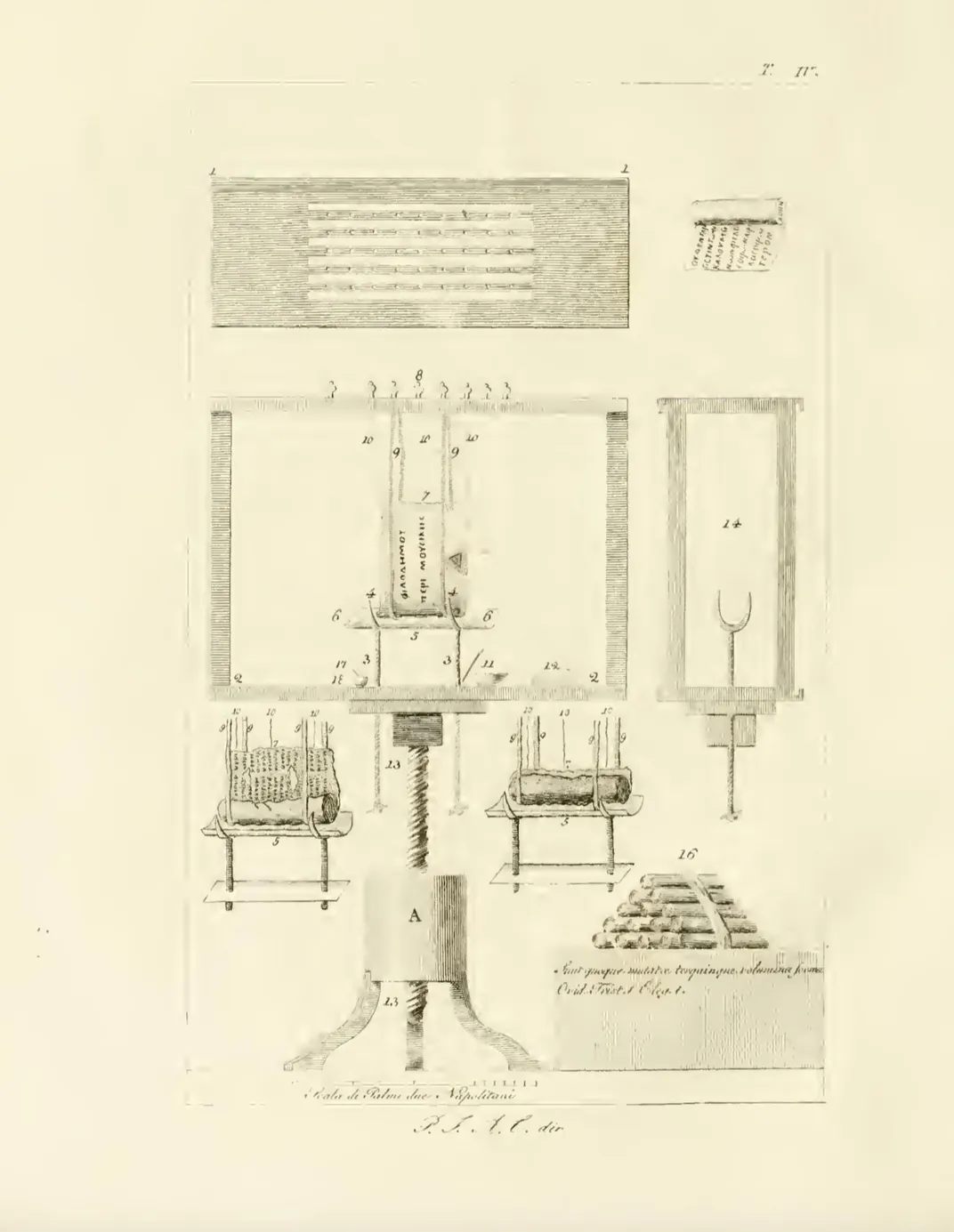
a centimeter an hour, using a machine designed by
Vatican conservator Antonio Piaggio.
Tesoro Letterario Di Ercolano, Tavola IV (1858)
Scholars searching the transcribed fragments for lost works of literature have largely been disappointed. A few pieces of Latin works were discovered, including parts of the Annales, by Quintus Ennius, a second-century B.C. epic poem about the early history of Rome, and Carmen de bello Actiaco, which tells of the final hours of Antony and Cleopatra. The vast majority of the opened scrolls contained Greek philosophical texts, relating to the ideas of Epicurus, an Athenian philosopher in the late fourth and early third centuries B.C., who believed that everything in nature is made up of atoms too small to see. Some are by Epicurus himself, such as a piece of On Nature, a huge work that was previously known but lost. But most are by Philodemus, an Epicurean employed by Piso in the first century B.C., and cover Epicurus’ views on ethics, poetry and music.
None of the Herculaneum scrolls has been opened since the 19th century, and scholars have instead focused on squeezing information out of the already-revealed texts. A step forward came in the 1980s, when Dirk Obbink of Oxford University and Daniel Delattre of France’s National Center for Scientific Research independently worked out how to reassemble fragments dissected under Paderni. In the 1990s, Brigham Young University researchers photographed the surviving opened papyri using multispectral imaging, which deploys a range of wavelengths of light to illuminate the text. Infrared light, in particular, increased the contrast between the black ink and dark background. That was a “huge breakthrough,” says Obbink. “It enabled us to read vastly more of the unrolled rolls.”
The new images triggered a wave of scholarship into Epicurean philosophy, which had been poorly understood compared with the rival ideas of Plato, Aristotle or the Stoics. But the texts were still incomplete. The beginnings of all the manuscripts remain missing. And the prose is often scrambled, because letters and words from different layers of a scroll wound up next to one another in two-dimensional renderings. “What we’d really like to do,” says Obbink, “is to read a text from beginning to end.”
That was thought impossible, until Seales saw the scrolls in Naples and realized that his research had been leading to exactly this grand challenge. “I thought, I’m a year away,” Seales says. “All I have to do is get access to the scrolls, and we can solve this.”
That was 13 years ago.
**********
Seales vastly underestimated, among other things, the difficulty of getting permission even to study the scrolls. Conservators are understandably reluctant to hand out these terribly fragile objects, and the library in Naples refused Seales’ requests to scan one. But a handful of Herculaneum papyri ended up in England and France, as gifts from Ferdinand, son of Charles III and King of Naples and Sicily. Seales collaborated with Delattre and the Institut de France, which has six scrolls in its possession. Two of the scrolls are in hundreds of pieces after past attempts to open them, and Seales eventually received permission to study three small fragments.
The first problem he hoped to solve was how to detect ink hidden inside rolled-up scrolls. From the late third century A.D. onward, ink tended to include iron, which is dense and easy to spot in X-ray images. But the papyri found at Herculaneum, created before A.D. 79, were written with ink made primarily of charcoal mixed with water, which is extremely difficult to distinguish from the carbonized papyrus it sits on.
At his lab in Kentucky, Seales subjected the papyrus scraps to a battery of noninvasive tests. He looked for trace elements in the ink—anything that might show up in CT—and discovered tiny amounts of lead, perhaps contamination from a lead inkwell or water pipe. It was enough for the Institut de France to give him access to two intact papyri: blackened sausage-shaped artifacts that Seales nicknamed “Banana Boy” and “Fat Bastard.” Seales arranged for a 600-pound high-resolution CT scanner to be sent by truck from Belgium, and he made intricately detailed scans of the scrolls. But after months of analyzing the data, Seales was disheartened to find that the ink inside the scrolls, despite the traces of lead, was invisible.
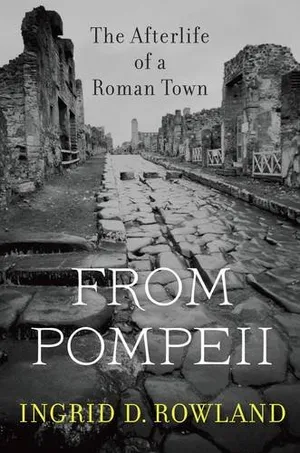
From Pompeii: The Afterlife of a Roman Town
The calamity that proved lethal for Pompeii inhabitants preserved the city for centuries, leaving behind a snapshot of Roman daily life that has captured the imagination of generations, including Renoir, Freud, Hirohito, Mozart, Dickens, Twain, Rossellini, and Ingrid Bergman. Interwoven is the thread of Rowland’s own impressions of Pompeii.
What was worse, the scans showed the layers inside the scrolls to be so carbonized that in many places there was no detectable separation between them. “It was just too complicated for our algorithms,” Seales admits. He played me a video of the CT scan data, showing one of the scrolls in cross-section. The whorls of papyrus glowed white against a dark background, like closely wound strands of silk. “Just take a look at that,” said Seales. “This is when we knew we were doomed for the present time.”
What makes virtual unwrapping such a complex challenge is that, even if you imaged the inside of a rolled-up scroll written in ink that glowed brightly in scans, you would still only see a dizzying mess of tightly packed letters floating in space, like a three-dimensional jigsaw puzzle—but without a final picture to use as a guide. To decipher that jumble of letters, Seales’ key innovation was to develop software to locate and model the surface layer within a wound-up scroll, which analyzes each point in as many as 12,000 cross-sections. Then he looks for density changes that correspond to the ink, and applies filters or other techniques to increase the contrast of the letters as much as possible. The final step is to figuratively “unroll” the image for reading.
Seales spent 2012 and 2013 as a visiting scientist at the Google Cultural Institute in Paris, amping up his algorithms to cope with the complex structures the CT scans had revealed. He got the chance to try his new approach soon afterward, when Pnina Shor, at the Israel Antiquities Authority, or IAA, in Jerusalem, contacted him about a carbonized roll of parchment found in the ancient town of Ein Gedi, on the western shore of the Dead Sea. The scroll was excavated from the remains of a synagogue, which was destroyed by fire in the sixth century A.D. The charred, cigar-shaped lump was far too fragile to open, but Israeli researchers had recently CT-scanned it. Would Seales take a look at the data? Shor handed over a hard drive, and Seales and his colleagues went to work.
In the meantime, Seales was chasing a new idea for reading carbon-based ink: X-ray phase-contrast tomography, a highly sensitive form of imaging that can detect subtle density changes in a material—the kind that might result from applying ink to papyrus—by measuring the changing intensity of the beam as it passes through an object. Only a large particle accelerator, though, can produce such a beam. One of the nearest was Synchrotron Soleil, outside Paris. Seales’ request for “beam time” there was rejected, but he and Delattre were subsequently approached by an Italian physicist named Vito Mocella, who had close ties to another synchrotron in Grenoble, in southeastern France. Seales provided custom-designed cases for the scrolls, built using data from his CT scans, but his schedule didn’t allow him to travel. So in December 2013, Delattre took Banana Boy and another scroll to Grenoble without him.*
Seales waited eagerly for the promised data, but the files did not arrive. Then, in January 2015, Mocella’s group published the results without him. It was, Seales says, an “excruciatingly frustrating” experience. “I believed we were collaborating, until I realized that the feeling was not mutual.”
News stories around the world reported that Herculaneum scrolls had been deciphered at last. But, in fact, Mocella had claimed to read only letters, and some scholars are cautious about even those, not least because the group did not publish enough information for others to replicate the analysis. Mocella finally shared his data with Seales and others after publication. After reviewing it, Seales concluded that the findings were a bust. “The dataset did not produce any contrast at the ink,” he told me. Seales thinks the researchers, who were without software to model the surfaces within the scrolls, were seeing “ghosts”—random patterns in the papyrus’ fiber structure that just happen to look like letters. He is now convinced that phase-contrast tomography alone is not sufficient to read the Herculaneum scrolls in any meaningful way. (Mocella insists the letters he saw were real, and he took issue with Seales’ version of the incident. “From my point of view, I and my team are still working with Brent, since we’ve given him, as with other specialists like him, most of the scans,” Mocella said.)
By that point Seales had finished a preliminary analysis of the Ein Gedi scroll, and in July 2015 he and the IAA announced their results. “We absolutely hit a home run,” Seales says.
Unlike the authors of the Herculaneum scrolls, the Hebrew scribes had mixed metals into their ink. Seales’ software correctly mapped the letters to the rolled-up parchment, then virtually unfurled it, revealing all of the surviving text, in perfect sequence, on each of the five wraps of the scroll. There were 35 lines of text in two columns, composed of Hebrew letters just two millimeters tall. Israeli researchers identified the text as the first two chapters of the Book of Leviticus, dating to the third or fourth century A.D. It was a hugely significant find for biblical scholars: the oldest extant copy of the Hebrew Bible outside of the Dead Sea Scrolls, and a glimpse into the history of the Bible during a period from which hardly any texts survive.
And it was proof that Seales’ method worked. Following Mocella’s publication, however, the Institut de France refused further access to its Herculaneum scrolls. Which is why Seales turned his attention to Oxford.
**********
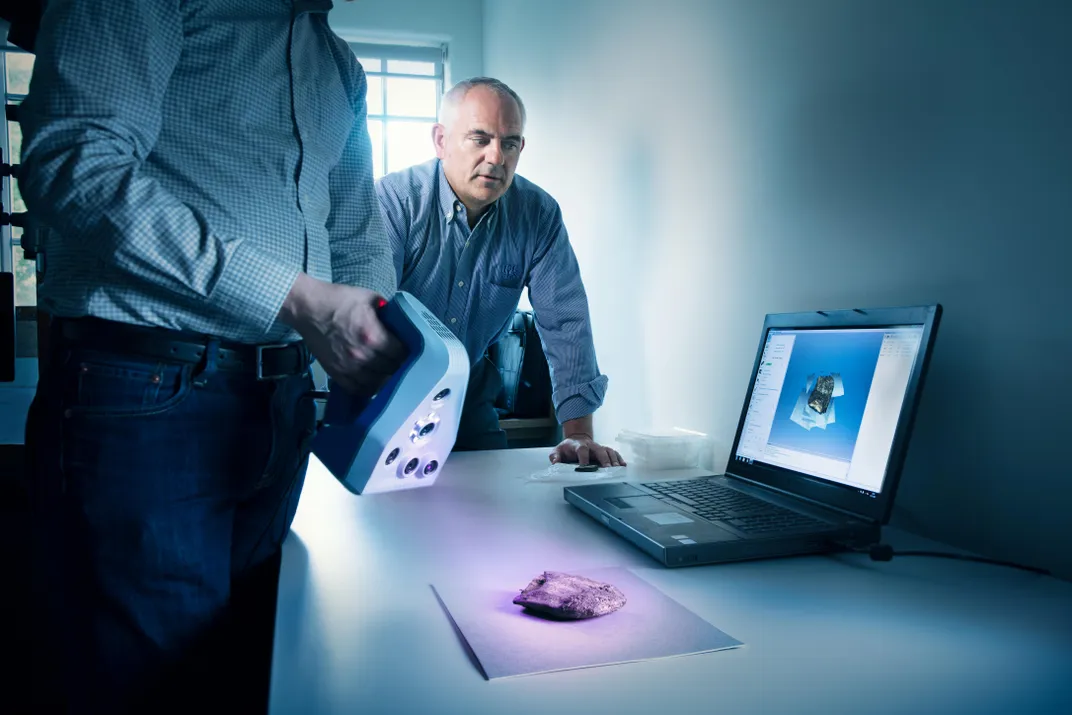
Henrik Knudsen
The Bodleian Libraries, at Oxford University, possess four Herculaneum scrolls, which arrived in 1810, after they were presented to the Prince of Wales. They are kept deep inside the building, in a location so secret that even David Howell, the Bodleian’s head of heritage science, says he doesn’t know where it is.
Seales wasn’t permitted to see the intact papyri, never mind scan them. But one of the four, known as “P.Herc. 118,” was sent to Naples in 1883, to be unrolled using Piaggio’s machine. It came back as a mosaic of crumbs, which were glued onto tissue paper and mounted behind glass in 12 wood frames. The text appears to be a history of Epicurean philosophy, probably by Philodemus, but it has been particularly challenging for scholars to interpret. A fragment might seem covered with continuous lines of writing, says Obbink, “but really every inch you’re jumping up or down a layer.”
To prove the value of his approach, Seales asked the Bodleian to let him analyze P.Herc. 118. If all went well, he hoped, he might get a shot at scanning the intact scrolls later. “We wouldn’t necessarily have chosen to get involved, except for Brent’s enthusiasm,” says Howell. So in July 2017, the 12 frames were removed from storage and taken to Howell’s third-floor office—something of a coup for Seales, given their invaluable nature. Cheerful and ruddy-faced, Howell has worked in conservation for close to 35 years, and even he felt daunted as the protective glass frames were removed, exposing the fragile papyrus beneath. “These are the most terrifying objects I’ve ever handled,” he says. “If you sneeze, they’d blow away.”
Seales and another colleague scanned these scroll fragments using a hand-held 3-D scanner called an Artec Space Spider. Meanwhile, Howell carried out hyperspectral imaging, which uses hundreds of wavelengths of light. Howell listened to Pink Floyd through noise-canceling headphones to escape the grinding noise of the scanner, he says, plus the knowledge that if anything went wrong, “I might as well pack my bags and go home and not come back.”
After Seales returned to Kentucky, he and his colleagues spent months mapping all of the available 2-D images onto the 3-D template produced by the Artec Space Spider. This past March, they returned to Oxford to present the results on a big screen to a packed conference room. At such a high resolution, the charred papyrus resembled a dark-brown mountain range as seen from above, with lines of text snaking over the ridges and peaks. There was a gasp from the audience as Seales’ student Hannah Hatch rotated the image, then zoomed into creases and peeked over folds, flipping seamlessly between high-resolution photographs, infrared images and even the disegni drawings—all matched up to the 3-D template.
Shortly afterward, James Brusuelas, an Oxford papyrologist working with Seales, revealed several new details visible in the scans, such as the name Pythocles, who was a young follower of Epicurus. More important, Brusuelas was able to decipher the column structure of the text—17 characters per line—which will be crucial for reading the rest of the roll, particularly when trying to join different fragments together. “We have the basic information we need to put Humpty Dumpty back together again,” he said.
The audience buzzed with questions and applause. It was the reaction Seales was hoping for, and a step toward his real goal—gaining access to intact scrolls.
He’d saved his own presentation until last. It wasn’t about P.Herc. 118, but rather one tiny letter: the lunate sigma.
**********
Driving south from the stone archways and quadrangles of Oxford, the road soon cuts through flat green fields reaching to the horizon. On the day I visited, fork-tailed red kites hovered high in the blue July sky. After 15 or so miles a sprawling campus of low gray buildings came into view. At first, it resembled an ordinary industrial park, until I noticed the names of the roads: Fermi, Rutherford, Becquerel, all giants of 19th- and 20th-century physics. Behind a wire fence a huge, silver dome, more than a quarter-mile in circumference, rose from the grass like a giant flying saucer. This was Diamond Light Source, and Seales was waiting inside.
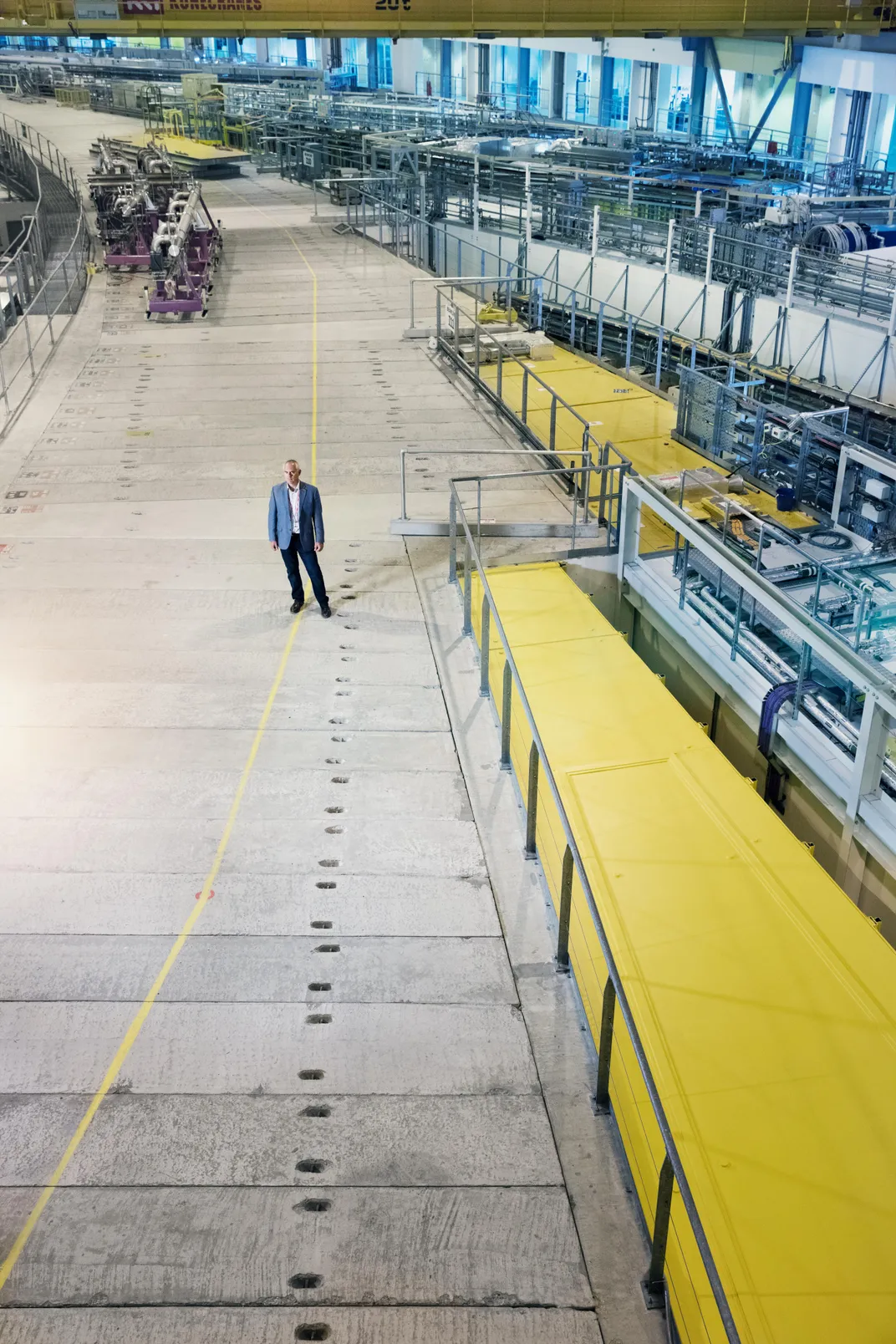
Henrik Knudsen
He’d brought a speck of charred papyrus from one of the Herculaneum scrolls he studied a decade earlier. The ink on it, he had found, contained a trace of lead. In Grenoble, direct X-ray imaging of the scrolls had not been enough to detect the ink. But when you fire hugely powerful X-rays through lead, the metal emits electromagnetic radiation, or “fluoresces,” at a characteristic frequency. Seales hoped to pick up that signal with a detector placed beside the fragment, which was specially calibrated to capture photons at lead’s characteristic frequency.
It was a long shot. The minuscule fluorescence of the letter would be swamped by radiation from the protective lead lining the room—like looking for a flickering candle from miles away on a rainy night, Seales said, as we stood in the crowded hutch. But after several days of intense work—optimizing the angle of the detector, shielding the main X-ray beam with tungsten “flight tubes”—the team finally got what it was looking for: a grainy, but clearly recognizable, “c.”
“We’ve proven it,” Seales said in triumph as he displayed the legible image to the Oxford audience in March. It is, Seales hopes, the last piece of the puzzle he needs to read the ink inside a Herculaneum scroll.
The results have scholars excitedly re-evaluating what they might now be able to achieve. “I think it’s actually very close to being cracked,” says Obbink, the Oxford papyrologist. He estimates that at least 500 Herculaneum scrolls haven’t been opened. Moreover, excavations at Herculaneum in the 1990s revealed two unexplored layers of the villa, which some scholars believe may contain hundreds or even thousands more scrolls.
Many scholars are convinced that Piso’s great library must have contained a range of literature far wider than what has been documented so far. Obbink says he wouldn’t be surprised to find more Latin literature, or a once-unimaginable treasure of lost poems by Sappho, the revered seventh-century B.C. poet known today only through the briefest of fragments.
Michael Phelps, of the Early Manuscripts Electronic Library, in California, who recently used multispectral imaging to reveal dozens of hidden texts on reused parchment at St. Catherine’s Monastery, in Egypt, calls Seales’ methods “revolutionary.” Scholars have long faced a choice between attempting to read concealed texts (and potentially destroying them in the process) or conserving them unread. “Brent Seales’ technology is removing that dilemma,” Phelps says.
Successfully reading Herculaneum scrolls could trigger a new “renaissance of classical antiquity,” says Gregory Heyworth, a medievalist at the University of Rochester in New York. He points out that virtual unwrapping could be applied to countless other texts. In Western Europe alone, he estimates, there are tens of thousands of manuscripts dating from before A.D. 1500—from carbonized scrolls to book covers made from older, glued-together pages—that could benefit from such imaging.
“We’d change the canon,” Heyworth says. “I think the next generation is going to have a very different picture of antiquity.”
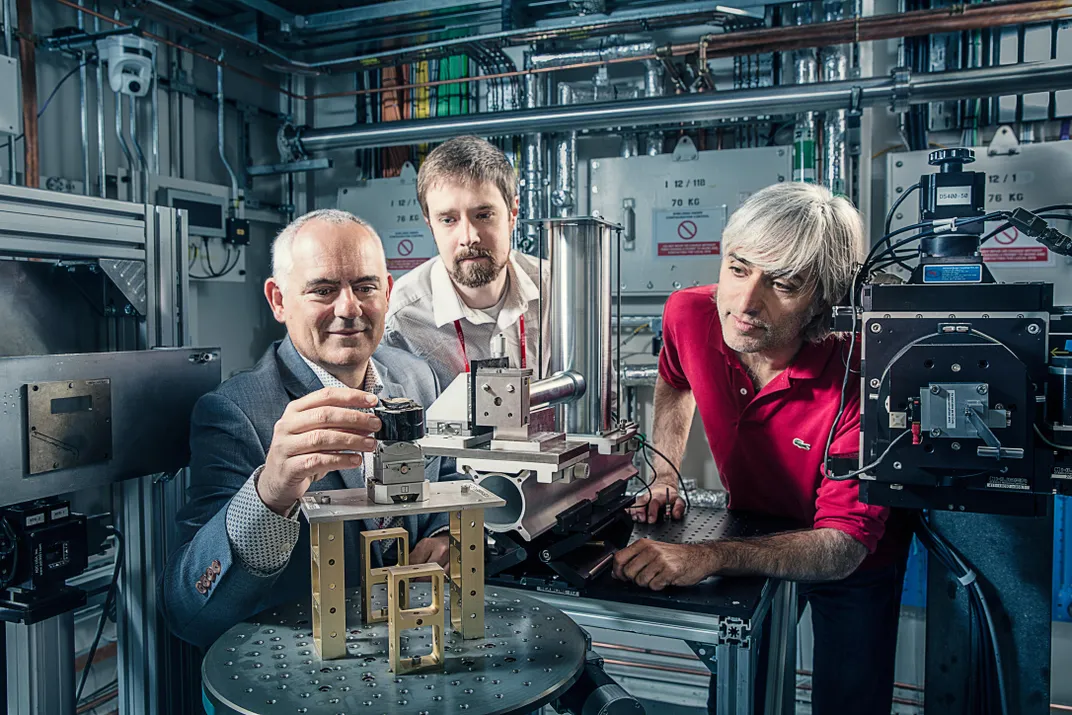
Henrik Knudsen
**********
Seales has lately been enhancing his technique, by using artificial intelligence to train his software to recognize subtle differences in texture between papyrus and ink. He plans to combine such machine learning and X-ray fluorescence to produce the clearest possible text. In the future, “it’ll all be automated,” he predicts. “Put it in the scanner and it will all just unfurl.”
Seales is still negotiating with curators in Oxford, Naples and Paris for access to intact scrolls. He has surmounted huge technical hurdles, but the complex political challenge of navigating the gatekeepers, winning beam time at particle accelerators and lining up funding can, very occasionally, puncture his optimism. “How does a guy like me make all that stuff happen all at once?” he said in one such moment. He shrugged and looked around him. “It’s more than a computer scientist is really capable of doing.”
Then belief returned to his wide, hazel eyes. “I refuse to accept that it’s not possible,” he said. “At every turn, there has been something that opened up.” Reading a complete intact scroll at last, he went on, would be “like returning home to your family, who have been waiting all along for you to do the thing you started.”
*Editor’s Note: This article was updated to correct the name of the French research facility that declined Seales’ proposal to scan a Herculaneum scroll, and to clarify how the scrolls were ultimately scanned at Grenoble.
